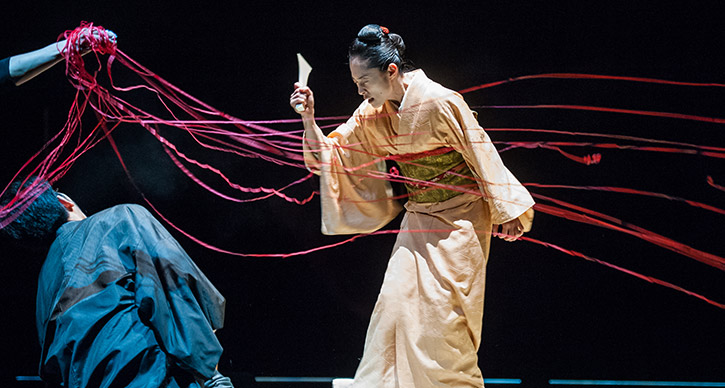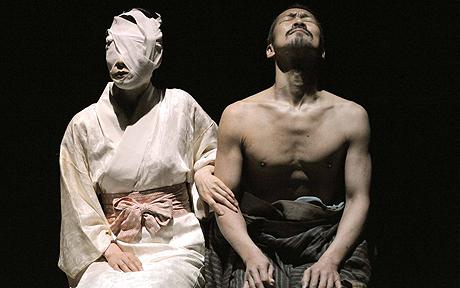On Tanizaki: The long arc of Japan’s most highly regarded writers
Editor’s note: British theater company Complicite performs Complicite performs Shun-kin with Setagaya Public Theatre in Ann Arbor Septer 18-21, 2013. Shun-kin is based on a story by Junichiro Tanizaki.
Photo: From Shun-kin. Photo by Stephanie Berger.
In 1933, Tanizaki Junichiro published two of his best-known works: the novella “A Portrait of Shunkin,” which appeared in June, and In Praise of Shadows, an essay on Japanese aesthetics published in December of that year. In many ways these two works are suggestive both of the long arc of Tanizaki’s career as one of Japan’s most highly regarded writers – a career that had begun two decades earlier – and of a new direction Tanizaki’s work would take in the decades following the Great Kanto Earthquake of 1923.
Although Tanizaki’s work was characterized from the start of his career by modern and even modernist aesthetic impulses, he was also intensely interested in Japan’s past. His debut work, “The Tattooer” (1910), which the novelist Nagain Kafu hailed as a masterpiece of modern fiction and which would launch Tanizaki’s career, is set – like “Shunkin” – in Japan’s Edo period (1600-1868) and explores the aesthetic powers of traditional Japanese tattooing, in many ways anticipating themes to which Tanizaki would return two decades later.
But much of Tanizaki’s work in the intervening decades would take up distinctly modern subjects: his “detective” fiction, like “The Thief,” would explore aspects of psychology and Freudian psychoanalysis, and Naomi, Tanizaki’s best known work, uses a Pygmalion-like tale to explore gender relations in contemporary society under the influence of the West. Nothing in this work suggests a writer who would call, in 1933, for a return to the Japanese classics or who would spend decades translating the eleventh-century Tale of Genji into modern Japanese.
In the context of Tanizaki’s work from the 1920s, “Shunkin” represents a return to the themes he explored in “The Tattooer” but also a turn to an interest in traditional Japanese aesthetics that we see more fully developed in his essay In Praise of Shadows and that would occupy Tanizaki through the war years and for much of the rest of his life. And these turns and returns would themselves take place within the larger context of what, in 1938, the poet Hagiwara Sakutaro would call “a return to Japan,” a return to aesthetic practices that had disappeared in the wake of Western-style modernity.
The Great Kanto Earthquake of 1923 is often used to mark a dividing line in Tanizaki’s career. The earthquake completely leveled the city of Tokyo where Tanizaki was born and raised, and the novelist would spend the next three decades living in the Kansai region—first in Kyoto, then in Kobe, and then in Hyogo Prefecture. In the wake of this move, Tanizaki became preoccupied with aspects of traditional Japanese aesthetics that he would explore in works like “Shunkin” – which focuses on a blind samisen player and her disciple/lover in the first half of the nineteenth century.
But if “Shunkin” takes as its subject what Tanizaki himself would call the “traditional” world of old Japan, it does so through a very modernist narrative which constantly calls into question its own veracity through the device of an “unreliable narrator” – a technique that calls to mind the work of Conrad and Ford Maddox Ford, and that Tanizaki had earlier explored in works like “The Thief.” What is interesting about this technique in “Shunkin” is how it seems to suggest a potentially wry reading of Tanizaki’s essay In Praise of Shadows and a more complicated picture of Tanizaki’s relationship to Japan’s past.
One of the most pronounced aspects of “Shunkin” is not just how the narrator himself repeatedly calls into question the veracity of the evidence he uses to piece together the “portrait” of these two nineteenth-century figures, but also how the narrator provokes the reader’s distrust of his own account and his own motives – even if we are ultimately unsure of who the narrator is or what his motives may be. The ‘past’ in “Shunkin” is dim and faded – like the lone surviving photograph of Shunkin – but it is also easily manipulated to tell any story that the narrator decides upon and Tanizaki must surely have sensed how similar was Japan’s past: one could create stories, even fantasies, out of whole cloth with the merest of support, create an entire aesthetic theory like what Tanizaki himself attempts in In Praise of Shadows, but this would always be filtered through the teller’s consciousness, easily manipulated to present a story only loosely based on reality.
It has been common to read In Praise of Shadows earnestly and to take seriously Tanizaki’s call in for a return to a subdued aesthetics that “would push back into the shadows the things that come forward too closely” based on principles most closely associated with Japanese Zen. But the narrative voice in this essay – Tanizaki’s own voice, we presume – is itself quite similar to the voice Tanizaki uses for the narrator in “Shunkin” (written six months earlier) who pieces together Shunkin’s story based on a short manuscript, a single photograph, gossip, rumor, and hearsay mixed together with his own mostly prurient speculation. And just as we begin to doubt the “Shunkin” narrator’s reliability through his digressions and idle speculations, Tanizaki seems intent on provoking his readers when he speculates how different certain technologies – the fountain pen, the camera, the phonograph – might have been had they been invented by the Japanese: “had we invented the phonograph and the radio, how much more faithfully they would reproduce the special character of our voice and our music.”
The idea is arresting but, like the “Shunkin” narrator’s own ruminations on his subject, it remains vague and speculative, and the reader is not always sure how seriously to take Tanizaki’s In Praise of Shadows. But many of the ideas Tanizaki puts forth in this essay have taken hold in thinking about Japanese aesthetics both in Japan and in the West, and it has been common to ignore what the work’s translator, Thomas Harper, called Tanizaki’s “perverse habit of shifting without warning from a tone of high seriousness to something near facetiousness.”
When considering these two works from 1933 together, it has been common to search the ‘nonfiction’ In Praise of Shadows for clues to the world of traditional musicianship presented in the “Shunkin,” the work of fiction. But in many ways it is “Shunkin” itself that provides a clue to understanding not just In Praise of Shadows but so much of Tanizaki’s later career as an often self-conscious and ironic “unreliable narrator” of Japan’s past.
Between servant and mistress, over and over
Editor’s note: This essay is by Simon McBurney, director of British theater company Complicite. Complicite performs Shun-kin with Setagaya Public Theatre in Ann Arbor Septer 18-21, 2013.

Photo by Brookie (own work) via Wikimedia Commons.
In Japan, sometimes, it is hard to know what you are looking at.
I gaze at the symbols beside me, my underwear still around my ankles. There are at least ten. It is the one to flush I am looking for. Not the one that sprays perfume in the bowl, or worse still sprays to ‘clean’ from various angles and intensities, nor the one that blows hot air to dry you afterwards or plays the sound of tinkling water when you urinate so no one outside the door can hear you. Nor the one that heats the seat although I must have already pressed it because I feel my nether regions are cooking the longer I sit here. No. I simply want to push the one that will flush. The toilet is made of one piece of pressed plastic of a worrying flesh color. In fact the whole of the room is made from a single piece of plastic, no joins anywhere. Easy to clean I imagine. For one moment I wonder if there is a button that will set off a tsunami of cleansing product to sluice the entire room. I hesitate with my finger over the icons.
“…the Japanese toilet truly is a place of spiritual repose. It always stands aside from the main building, at the end of a corridor, in a grove fragrant with leaves and moss. No words can describe that sensation as one sits in the dim light, basking in the faint glow reflected from the shoji, lost in meditation or gazing out at the garden…surely there can be no better place than a Japanese toilet where…[one] looks out upon blue skies and green leaves. There are certain prerequisites: a degree of dimness, absolute cleanliness, and quiet so complete one can hear the hum of a mosquito. I love to listen from such a toilet to the sound of softly falling rain, especially if it is a toilet in the Kanto region…Compared to Westerners, who regard the toilet as utterly unclean and avoid even the mention of it in polite conversation, we are far more sensible and certainly in better taste…our forebears, making poetry of everything in their lives, transformed what by rights should be the most unsanitary room in the house into a place of unsurpassed elegance, replete with fond associations with the beauties of nature.”
So wrote Jun’ichiro Tanizaki in his 1933 essay on aesthetics entitled In Praise of Shadows. But here in 2008, gazing at the buttons at the side of my all-in-one plastic computer loo on the 22nd floor of my Tokyo high-rise, I would be hard pressed to term this “…a place of unsurpassed elegance, replete with fond associations with the beauties of nature.” And when, finally, I take the plunge and press on a button with what seems to be an icon for “flush”, I am electrified by the powerful spurt of extremely hot water in a delicate area of my anatomy.
When I first read In Praise of Shadows in 1996, I was rapt. As Charles Moore says in his introduction: “It comes with the thrill of a slap for us to hear praise of shadows and darkness…darkness (which) illuminates a culture very different from our own; but at the same time allows us to look deep into ourselves to our own inhabitation of the world…”
Our inhabitation of the world
Our inhabitation of the world: where light is synonymous with progress. We talk, in the West, of “enlightenment’ as a term of understanding. Yet the understanding that Tanizaki requires us to engage in, is another way of looking, to see something in the unknown, seeing beauty in shadow and darkness.
“The quality we call beauty, however, must always grow from the realities of life, and our ancestors, forced to live in dark rooms, presently came to discover beauty in shadows, ultimately to guide shadows towards beauty’s ends.”
A Westerner, Tanizaki suggests, has no sense of how the blackness of the lacquer bowl is beautiful precisely because you cannot see the soup within. You must divine what is in it by closing your eyes and smelling; you must imagine, see without seeing. “What lies within the darkness one cannot distinguish, but the…fragrance carried upon the vapor brings a delicate anticipation.”
The beauty of an old pot, for example, is enhanced because age has darkened it and time cracked its perfection. Its imperfection is an essential part of its beauty suggesting a life lived, rather than a goal achieved.
And if you really want to meet your love, then the best place is in the very heart of a Japanese house where the light almost does not penetrate, and where to make herself even more beautiful the woman of your dreams blackens her teeth. This last image an anathema to us, given our obsession with the white plastic smile.
I personally, however, am quite focused on achieving a goal as I walk out into the street on my day off here in Tokyo. I can think of nothing except the project of bringing Tanizaki’s words to life, which is particularly worrisome as his works are regarded as classics. This is not something a foreigner should necessarily get his hands on, particularly if he does not speak Japanese. And right now I am surrounded by concrete and neon. Not wood and paper. At least I gave up some years ago thinking I could simply use this polemic on darkness, In Praise of Shadows, as the only text. I thought there must be something the audience could look at if it were to be played in a theatre. And so I was pointed towards A Portrait of Shun-kin.
A Portrait of Shun-kin
In 1933, at the same time as publishing In Praise of Shadows, Tanizaki writes another story about seeing without seeing. A Portrait of Shun-kin. The story of Shun-kin; the true account of a blind female shamisen player and composer who lived in the mid-19th century. Unconventional and ravishingly beautiful, the musician Shun-kin lived with her servant, Sasuke. At first simply a serving boy whose duty it was to lead her around, he later became her pupil and then her lover; it is a shadowy love story that places at its center the power of the imagination in darkness. Because Shun-kin was blind, her servant Sasuke, in his desire and love to inhabit Shunkin’s world, blinds himself. The story begins with the facts:
“Shun-kin (born as Mozuya Koto, but better known by her professional name) was the daughter of an Osaka drug merchant. She died on the fourteenth of October in 1886 – the nineteenth year of the Meiji Era – and was buried in the grounds of a Buddhist temple of the pure land sect in the Shitadera district of Osaka.”
The style is that of highly detailed scholarly research into the life of this remarkable and distinguished 19th-century composer and musician. Sunk in the sensual dimness of the world of In Praise of Shadows, and dealing with another kind of darkness, that of the eroticism of mistress and servant, I fell for it. I decided to do some research of my own. So I googled Shun-kin.
But I guess I should have known when first starting out on this project nearly ten years ago, that if I could not work out the symbols on a plastic toilet, how could I possibly grasp the subtleties of the Japanese text obliterated by translation. Shun-kin is, of course, Tanizaki’s creation and never existed. But, I am happy to say, I was not the only one to have been taken in by the authentic tone of Tanizaki’s mock documentary style. Much of the critical establishment in Tokyo at the time was similarly flummoxed.
Pseudo-documentary ‘fact’ in A Portrait of Shun-kin is developed in extraordinary detail. The effect is to create a densely textured world where it is almost impossible not to accept that the figure of Shun-kin is an historical figure. Indeed we wonder where this is all going as the facts amassed seem to distance us from the emotional heart of the story itself. Nothing is clear.
Nothing is clear to me either as I wander the streets of Ikebukuro after my unfortunate affair with the toilet. The intensity of the streetlight seems to make a mockery of the idea that “darkness” should be celebrated in a meaningful way as Tanizaki writes. I begin to feel, not for the first time, that In Praise of Shadow is merely an exercise in historical nostalgia. Worse still a kind of nationalistic call for a specific cultural distinction in the jingoistic atmosphere of Japan in 1930. And maybe A Portrait of Shun-kin is merely an excuse for him to delve into his own perverted fantasies about submissive men and dominant women. Not for the first time in this extraordinary country I feel lost.
Across the road from me people are pouring out of a club. I watch fascinated as a group of young women chatter and laugh and hang out. Of course this sight in itself is not strange. It is only that they are all carrying violin cases and are dressed as Little Bo Peep. All of them. Like walking versions of the fake Delft porcelain shepherdesses that I saw aged nine in the windows of bed-and-breakfast lodgings when we went on holidays to the seaside. I sneak nearer to see what this is all about. One of them opens her case to show to another. I am close enough to see inside. There, nestling among the purple violin-protecting velour, is a doll. An exact replica of the girl who is showing her to her friend. The same bonnet, the same ruffled dress hoicked up to show the same white little girl stockings. Even the face has been replicated. Or has the girl’s face been made up to replicate the doll. It is not clear.
A severe problem in translation
In Japan, sometimes, it is hard to know what you are looking at.
For not only is the story of Shun-kin a series of strange fake documentary fragments, but its origin is not Japanese at all. Tanizaki took the idea from a Thomas Hardy short story in a collection entitled Some Noble Dames. The story in question rejoices in the title of Barbara of the House of Grebe. In this tale is also a narrator who pieces together the story from various sources, using guess work, and also quoting from so-called accounts of the period. It also evokes a vanished historical period, and then explores a sado-masochistic relationship, with scenes of terrible mutilation and its effect on that liaison. But there the comparison ends. The masochism in Tanizaki is, unlike the Hardy, a positive thing. Not merely because he was a masochist himself. But perhaps because such “perversions” do not carry the same stigma in Japan. “Kinky” relationships are allowed to unfold, at least in Tanizaki’s texts, with none of the same anxious guilt we in the West might have about such things. And in A Portrait of Shun-kin everything is distanced by this dense and complicated narrative technique.
Only while reading aloud with the actors did I become aware of a severe problem in translation. But one that, ultimately, opened a door on to what Tanizaki was doing in the original Japanese. I had asked the actors to pause at the end of sentences, only to find that I appeared to have a rebellion on my hands.
“What’s going on?” I asked.
I was met with a polite silence and then my translator Manabu Noda pointed out, “There are no full stops.”
“What?”
“No short phrases to quicken the narrative. His writing here is consciously recalling an archaic Japanese style.”
Perversion in narrative
Meandering and crossing one event into another the narrative itself does not progress, as it does in Hardy’s tale, to actions where we want to know what will happen next, where we wait for the “frightful consequence.” On the contrary, Tanizaki seems to deliberately subvert the idea of such an approach. In vain did we try to imagine there was more action and when we started to rewrite the whole text everything began to fall apart. The rehearsal ground to a halt. And we went home for the weekend.
I was thinking of what we would do next as I left the shepherdesses and wandered despairingly among the interconnected infinite miles of shopping malls in Ikebukuro. To be frank, and not for the first time, I wondered if we would be able to make anything at all. There was nothing to do but to submit to what was there. OK so the scenes repeated over and over rather than driving a narrative forward. But surely this was the point. A rhythm was established. An atmosphere poetically evoked. A perverse relationship examined and excavated. And as Slavoj Zizek puts it: “…in perversion the narrative remains stuck in the same place and repeats itself indefinitely – that is to say, the perverse narrative is unable to “progress” properly.” Perhaps this was Tanizaki’ s intention.
Shun-kin and Sasuke seem to re-enact a series of rituals, which lead to the climax of Sasuke blinding himself. They work as a kind of music might do. Building in waves of intensity. Using the interwoven voices, voices of narrative, not dialogue. In the dramatic situations there is nothing to say between them. They are sometimes not even dramatic. There is only the relationship of mistress and servant. It is a play of actions. The same actions. Over and over. Leading. Washing. Dressing. Cleaning. Obeying. Ordering. Time passes. Time wears. The faults begin to show. And then, only then when the worst can happen, just as the pot only becomes beautiful when it has a crack in it, is the real beauty and intensity of this relationship revealed.
However, nothing is sure; nothing is completely clear; even in this climax. Who disfigures Shun-kin? Why did Sasuke not hear the intruder who disfigures her entering her room, given that he has slept all his life in the next room? Tanizaki even emphasizes this by giving us several different accounts of what happened. Each telling a different version of events.
There is only something to be felt
The only way to approach it is to embrace such uncertainty. So given they, both Shun-kin and Sasuke, are narcissists who are so obsessed with each other they even give up their children for adoption, we could imagine anything. We could even imagine that Sasuke disfigures Shun-kin himself in order to incorporate her more perfectly into his fantasy world. And in blinding himself, that fantasy becomes perfect. But stop speculating my cast tells me. It is precisely the author’s intention that we should be left in ambiguity. There is nothing to be “illuminated,” to be made clear in the English sense of narrative drive. There is perhaps nothing even to ‘understand’, there is only something to be felt. Trust what happens when you read it. When you read the story, the moment of their coming together in their blindness is extraordinary. And it is given in the words themselves. Take the narrative voices away and something falls to bits.
To play the situations of the story without the sprawling sentences that interlock like an intricate piece of Japanese architecture would be to destroy the nature of the tale. The perverse character of Shun-kin is revealed within the convoluted syntax itself, as is the tangled pain of Sasuke’s adoration. In order Japanese prose there was a minimum of full stops. And as my cast pointed out to me, it is no accident that the sentence recounting Sasuke’s blinding is the longest in the book. Ah, so it was not surprising that I had no idea of what he was getting at. Because in the English version, this sentence is translated in neat short phrases. Almost as if it were ‘clarifying’ or illuminating the original. But that was not Tanizaki’s intention. He was creating obscurity. Shadows. To evoke the sense of impending blindness he expressed the tortuous and gathering darkness in the very fabric of the words themselves.
I step onto one of the endless escalators in the labyrinthin shopping center. Coming down the other way are the shepherdesses with their violin cases. Some chattering. Behaving as if there were nothing strange in what they are wearing at all. Beyond them is a vast window into the street. Snow is falling. In Japan it is hard sometimes to know what you are looking at.
“The quality we call beauty, however, must always grow from the realities of life…”
And there is for a moment something exquisitely beautiful about this sight. It is there for a moment. And then it is gone. Forever.
Complicite performs Shun-kin with Setagaya Public Theatre in Ann Arbor Septer 18-21, 2013.
UMS Book Club with Nicola’s Books
New this season, UMS is kicking off UMS Book Club. UMS and Nicola’s Books have teamed up to assemble a list of fiction, poetry, and non-fiction, matching six performances with books that carry similar themes, messages, or character traits. Get reading and dig deep into elements of the performance.
Here’s how to join
Pick up a book from the UMS Book Club list at Nicola’s Books (at a special discount of 15%) and unlock a special offer of up to 25% off to the related performances. Nicola’s Books is located at 2513 Jackson Avenue, Westgate Shopping Center, Ann Arbor, MI 48103.
You can use the code online at ums.org. You can also call our UMS Ticket Office at 734.764.2538 or visit the Michigan League Ticket Office. Be sure to mention the the promo code at the start of your order.
This offer is not valid on previously purchased tickets, in conjunction with any other offer, or at the door on the evening of the performance.
The books
 Book: Seven Japanese Tales by Jun’ichirō Tanizaki
Book: Seven Japanese Tales by Jun’ichirō Tanizaki
Performance: Complicite: Shun-kin, September 18-21, 2013 at Power Center
Inspired by the work of one of the most important Japanese writers of the 20th century, Jun’ichirō Tanizaki, Shun-kin tells a tale of devotion, passion, and power, where beauty is unforgiving and love is blinding.
 Book: The Age of Miracles by Karen Thompson Walker
Book: The Age of Miracles by Karen Thompson Walker
Performance: Ballet Preljocaj, November 1-2, 2013 at Power Center
And Then, One Thousand Years of Peace, which will be seen only at UMS, BAM, and Minneapolis, was first created by Angelin Preljocaj for the Bolshoi Ballet in 2010 and takes inspiration from the vision of apocalypse conjured by St. John in the biblical Book of Revelation. Karen Thompson Walker’s acclaimed novel is about a quieter apocalypse, when the Earth’s rotation slows, is a coming-of-age tale that clings to hope in light of a collapsing world.
 Book: Shostakovich: A Life Remembered by Elizabeth Wilson
Book: Shostakovich: A Life Remembered by Elizabeth Wilson
Performance: Kremerata Baltica, February 6, 2014 at Hill Auditorium
Kremerata Baltika will perform Shostakovich’s Anti-formalist Gallery, a dangerously satirical cantata never intended to be published or performed, as it would have imperiled his safety. In her biography of the composer, Elizabeth Wilson covers the discrepancies between Shostakovich’s public image and private life “from his early successes to his struggles under the Stalinist regime, and his international recognition as one of the leading composers of the twentieth century” through the reminiscences of his contemporaries and his personal writings.

Performance: Théâtre des Bouffes du Nord: The Suit, February 19-22, 2014 at Power Center
Peter Brook’s tender production makes Can Themba’s tightly crafted, unsettling fable sing. African melodies and Schubert lieder thicken the air of this apartheid-era summer in which a shared wound is not allowed to heal. This collection of stories from the African continent, presenting many different visions of Africa and reflecting on the continent’s tragic, imperialized history, includes Can Themba’s fable.
 Book: Tropicana Nights: The Life and Times of the Legendary Cuban Nightclub Paperback by Rosa Lowinge
Book: Tropicana Nights: The Life and Times of the Legendary Cuban Nightclub Paperback by Rosa Lowinge
Performance: Alfredo Rodríguez Trio and Pedrito Martinez Group, March 14, 2014 at Michigan Theater
This double-bill performance features percussionist and vocalist Pedrito Martinez, who incorporates the folklore of his Cuban roots with religious Yoruba chants and batá melodies into the traditional clave beat of popular Latin jazz, and Cuban-born Alfredo Rodríguez, a young pianist of astonishing virtuosity and imagination, performs with the open spirit of a culture rooted in dancing. These musicians represent a new generation of Cuban-influenced music, while Rosa Lowinge’s Tropicana Nights is a window into the culture and history of pre-Revolutionary Cuba through Havana’s notorious Tropicana nightclub, an estate frequented by legends like Nat “King” Cole, Liberace, Josephine Baker, and Ernest Hemingway.
 Book: The Essential Rumi
Book: The Essential Rumi
Performance: Asif Ali Khan Qawwali Music of Pakistan, March 21, 2014 at Rackham Auditorium
If the late, great Nusrat Fateh Ali Khan (1948-97) was known as “the emperor of Qawwali,” Asif Ali Khan — who was once hailed by the maestro as one of his best students — has surely emerged as the music’s reigning prince. Asif is a superstar in his native Pakistan and a powerful figure on the international stage, remaining faithful to the sublime traditions of devotional Sufi music. Rumi is perhaps the most well-known exponent of Sufi poetry; both spiritual and carefully crafted, these poems aim to reveal the human soul.
Did you read one of these books and attend the related performance? Share your thoughts or questions in the comments below.





